The Effects of Organic Mulches on Water Erosion Control for Skid Trails in the Hyrcanian Mixed Forests
Abstract
:1. Introduction
- (1)
- Both litter and sawdust are suitable mulching materials for reducing runoff and nutrient loss in the skid trails;
- (2)
- Sawdust is more effective than litter as a mulch material;
- (3)
- For both litter and sawdust mulch, a higher application rate implies higher efficiency in reducing runoff and nutrient loss.
2. Materials and Methods
2.1. Site Description
2.2. Experimental Design
2.3. Data Collection and Laboratory Analysis
2.4. Statistical Analyses
3. Results
3.1. Runoff and Sediment Yield
3.2. Nitrate (NO3-N) and Phosphate (PO4-P) Concentrations
3.3. Rainfall and Soil Properties
4. Discussion
5. Conclusions
- Both litter and sawdust are effective mulching options to reduce erosion and nutrient loss from skid trails;
- Sawdust was more effective than litter;
- For both litter and sawdust, increasing the application rates led to decreased erosion and nutrient loss;
- The mulching application rates of 7.6–14.6 Mg ha−1 and 5.3–11.4 Mg ha−1 for litter and sawdust, respectively, were revealed to be the best solutions to alleviate adverse effects and to maintain soil and water conservation after logging operations on skid trails.
Author Contributions
Funding
Data Availability Statement
Acknowledgments
Conflicts of Interest
References
- Sohrabi, H.; Jourgholami, M.; Labelle, E.R. The effect of forest floor on soil microbial and enzyme indices after forest harvesting operations in Hyrcanian deciduous forests. Eur. J. For. Res. 2022, 141, 1013–1027. [Google Scholar] [CrossRef]
- Latterini, F.; Dyderski, M.K.; Horodecki, P.; Picchio, R.; Venanzi, R.; Lapin, K.; Jagodziński, A.M. The Effects of Forest Operations and Silvicultural Treatments on Litter Decomposition Rate: A Meta-analysis. Curr. For. Rep. 2023, 9, 276–290. [Google Scholar] [CrossRef]
- Filothei, M.; Petros, G. Effect of land preparation methods on restoration success of degraded oak forest ecosystems. Dendrobiology 2023, 89, 56–64. [Google Scholar] [CrossRef]
- Fan, D.; Jia, G.; Wang, Y.; Yu, X. The effectiveness of mulching practices on water erosion control: A global meta-analysis. Geoderma 2023, 438, 116643. [Google Scholar] [CrossRef]
- Manral, V.; Bargali, K.; Bargali, S.S.; Jhariya, M.K.; Padalia, K. Relationships between soil and microbial biomass properties and annual flux of nutrients in Central Himalaya forests, India. Land Degrad. Dev. 2022, 33, 2014–2025. [Google Scholar] [CrossRef]
- Saba, T.; Liu, W.; Wang, J.; Saleem, F.; Kang, X.; Hui, W.; Gong, W.; Li, H. Effects of organic supplementation to reduced rates of chemical fertilization on soil fertility of Zanthoxylum armatum. Dendrobiology 2022, 87, 123–136. [Google Scholar] [CrossRef]
- Picchio, R.; Jourgholami, M.; Zenner, E.K. Effects of Forest Harvesting on Water and Sediment Yields: A Review toward Better Mitigation and Rehabilitation Strategies. Curr. For. Rep. 2021, 7, 214–219. [Google Scholar] [CrossRef]
- Shah, N.W.; Baillie, B.R.; Bishop, K.; Ferraz, S.; Högbom, L.; Nettles, J. The effects of forest management on water quality. For. Ecol. Manag. 2022, 522, 120397. [Google Scholar] [CrossRef]
- Cristan, R.; Aust, W.M.; Bolding, M.C.; Barrett, S.M.; Munsell, J.F.; Schilling, E. Effectiveness of forestry best management practices in the United States: Literature review. For. Ecol. Manag. 2016, 360, 133–151. [Google Scholar] [CrossRef]
- Scholten, T.; Seitz, S. Soil erosion and land degradation. Soil Syst. 2019, 3, 68. [Google Scholar] [CrossRef]
- Chaubey, P.K.; Mall, R.K.; Jaiswal, R.; Payra, S. Spatio-Temporal Changes in Extreme Rainfall Events over Different Indian River Basins. Earth Space Sci. 2022, 9, e2021EA001930. [Google Scholar] [CrossRef]
- Touma, D.; Stevenson, S.; Swain, D.L.; Singh, D.; Kalashnikov, D.A.; Huang, X. Climate change increases risk of extreme rainfall following wildfire in the western United States. Sci. Adv. 2022, 8, eabm0320. [Google Scholar] [CrossRef] [PubMed]
- Karwat, Z.; Koczan, G.; Rębkowski, B.; Kozakiewicz, P. Comparison beech wood tension strength parallel to grain of cylindrical samples with conical and funnel tapering versus standard rectangular cross section samples. Drewno 2022, 65, 1–22. [Google Scholar] [CrossRef]
- Łukawski, D.; Hochmańska-Kaniewska, P.; Janiszewska-Latterini, D.; Lekawa-Raus, A. Functional materials based on wood, carbon nanotubes, and graphene: Manufacturing, applications, and green perspectives. Wood Sci. Technol. 2023, 57, 989–1037. [Google Scholar] [CrossRef]
- Janiszewska-Latterini, D.; Pizzi, A. Application of Liquefied Wood Products for Particleboard Manufacturing: A Meta-analysis Review. Curr. For. Rep. 2023, 9, 291–300. [Google Scholar] [CrossRef]
- Labelle, E.R.; Lemmer, K.J. Selected Environmental Impacts of Forest Harvesting Operations with Varying Degree of Mechanization. Croat. J. For. Eng. 2019, 40, 239–257. [Google Scholar] [CrossRef]
- Salmivaara, A.; Launiainen, S.; Perttunen, J.; Nevalainen, P.; Pohjankukka, J.; Ala-Ilomäki, J.; Sirén, M.; Laurén, A.; Tuominen, S.; Uusitalo, J.; et al. Towards dynamic forest trafficability prediction using open spatial data, hydrological modelling and sensor technology. Forestry 2021, 93, 662–674. [Google Scholar] [CrossRef]
- Frey, B.; Kremer, J.; Rüdt, A.; Sciacca, S.; Matthies, D.; Lüscher, P. Compaction of forest soils with heavy logging machinery affects soil bacterial community structure. Eur. J. Soil Biol. 2009, 45, 312–320. [Google Scholar] [CrossRef]
- Labelle, E.R.; Hansson, L.; Högbom, L.; Jourgholami, M.; Laschi, A. Strategies to Mitigate the Effects of Soil Physical Disturbances Caused by Forest Machinery: A Comprehensive Review. Curr. For. Rep. 2022, 8, 20–37. [Google Scholar] [CrossRef]
- Nazari, M.; Arthur, E.; Lamandé, M.; Keller, T.; Bilyera, N.; Bickel, S. A Meta-analysis of Soil Susceptibility to Machinery-Induced Compaction in Forest Ecosystems across Global Climatic Zones. Curr. For. Rep. 2023. [Google Scholar] [CrossRef]
- Spinelli, R.; Magagnotti, N.; Schweier, J. Trends and perspectives in coppice harvesting. Croat. J. For. Eng. 2017, 38, 219–230. [Google Scholar]
- Mohieddinne, H.; Brasseur, B.; Spicher, F.; Gallet-Moron, E.; Buridant, J.; Kobaissi, A.; Horen, H. Physical recovery of forest soil after compaction by heavy machines, revealed by penetration resistance over multiple decades. For. Ecol. Manag. 2019, 449, 117472. [Google Scholar] [CrossRef]
- Busse, M.; Zhang, J.; Fiddler, G.; Young, D. Compaction and organic matter retention in mixed-conifer forests of California: 20-year effects on soil physical and chemical health. For. Ecol. Manag. 2021, 482, 118851. [Google Scholar] [CrossRef]
- Ponder, F.; Fleming, R.L.; Berch, S.; Busse, M.D.; Elioff, J.D.; Hazlett, P.W.; Kabzems, R.D.; Marty Kranabetter, J.; Morris, D.M.; Page-Dumroese, D.; et al. Effects of organic matter removal, soil compaction and vegetation control on 10th year biomass and foliar nutrition: LTSP continent-wide comparisons. For. Ecol. Manag. 2012, 278, 35–54. [Google Scholar] [CrossRef]
- Bottinelli, N.; Hallaire, V.; Goutal, N.; Bonnaud, P.; Ranger, J. Impact of heavy traffic on soil macroporosity of two silty forest soils: Initial effect and short-term recovery. Geoderma 2014, 217, 10–17. [Google Scholar] [CrossRef]
- Fu, Y.; Tian, Z.; Amoozegar, A.; Heitman, J. Measuring dynamic changes of soil porosity during compaction. Soil Tillage Res. 2019, 193, 114–121. [Google Scholar] [CrossRef]
- Ampoorter, E.; De Schrijver, A.; Van Nevel, L.; Hermy, M.; Verheyen, K. Impact of mechanized harvesting on compaction of sandy and clayey forest soils: Results of a meta-analysis. Ann. For. Sci. 2012, 69, 533–542. [Google Scholar] [CrossRef]
- Sohrabi, H.; Jourgholami, M.; Jafari, M.; Shabanian, N.; Venanzi, R.; Tavankar, F.; Picchio, R. Soil recovery assessment after timber harvesting based on the Sustainable Forest Operation (SFO) perspective in Iranian temperate forests. Sustainability 2020, 12, 2874. [Google Scholar] [CrossRef]
- De Melo, L.B.B.; Silva, B.M.; Peixoto, D.S.; Chiarini, T.P.A.; de Oliveira, G.C.; Curi, N. Effect of compaction on the relationship between electrical resistivity and soil water content in Oxisol. Soil Tillage Res. 2021, 208, 104876. [Google Scholar] [CrossRef]
- Pöhlitz, J.; Rücknagel, J.; Schlüter, S.; Vogel, H.-J.; Christen, O. Computed tomography as an extension of classical methods in the analysis of soil compaction, exemplified on samples from two tillage treatments and at two moisture tensions. Geoderma 2019, 346, 52–62. [Google Scholar] [CrossRef]
- Latterini, F.; Venanzi, R.; Tocci, D.; Picchio, R. Depth-to-Water Maps to Identify Soil Areas That Are Potentially Sensitive to Logging Disturbance: Initial Evaluations in the Mediterranean Forest Context. Land 2022, 11, 709. [Google Scholar] [CrossRef]
- Varol, T.; Emir, T.; Akgul, M.; Ozel, H.B.; Acar, H.H.; Cetin, M. Impacts of small-scale mechanized logging equipment on soil compaction in forests. J. Soil Sci. Plant Nutr. 2020, 20, 953–963. [Google Scholar] [CrossRef]
- Correa, J.; Postma, J.A.; Watt, M.; Wojciechowski, T. Soil compaction and the architectural plasticity of root systems. J. Exp. Bot. 2019, 70, 6019–6034. [Google Scholar] [CrossRef]
- Fernández, J.L.F.; Hartmann, P.; Schäffer, J.; Puhlmann, H.; von Wilpert, K. Initial recovery of compacted soil—Planting and technical treatments decrease CO2 concentrations in soil and promote root growth. Ann. For. Sci. 2017, 74, 73. [Google Scholar] [CrossRef]
- Hansson, L.; Šimůnek, J.; Ring, E.; Bishop, K.; Gärdenäs, A.I. Soil compaction effects on root-zone hydrology and vegetation in boreal forest clearcuts. Soil Sci. Soc. Am. J. 2019, 83, S105–S115. [Google Scholar] [CrossRef]
- Hernandez-Ramirez, G.; Ruser, R.; Kim, D.-G. How does soil compaction alter nitrous oxide fluxes? A meta-analysis. Soil Tillage Res. 2021, 211, 105036. [Google Scholar] [CrossRef]
- Latterini, F.; Dyderski, M.K.; Horodecki, P.; Rawlik, M.; Stefanoni, W.; Högbom, L.; Venanzi, R.; Picchio, R.; Jagodziński, A.M. A Meta-analysis of the effects of ground-based extraction technologies on fine roots in forest soils. Land Degrad. Dev. 2023. [Google Scholar] [CrossRef]
- Latterini, F.; Venanzi, R.; Picchio, R.; Jagodziński, A.M. Short-term physicochemical and biological impacts on soil after forest logging in Mediterranean broadleaf forests: 15 years of field studies summarized by a data synthesis under the meta-analytic framework. Forestry 2023, 96, 547–560. [Google Scholar] [CrossRef]
- DeArmond, D.; Ferraz, J.B.S.; Lovera, L.H.; de Souza, C.A.S.; Corrêa, C.; Spanner, G.C.; Lima, A.J.N.; dos Santos, J.; Higuchi, N. Impacts to soil properties still evident 27 years after abandonment in Amazonian log landings. For. Ecol. Manag. 2022, 510, 120105. [Google Scholar] [CrossRef]
- Karami, S.; Jourgholami, M.; Attarod, P.; Venanzi, R.; Latterini, F.; Stefanoni, W.; Picchio, R. The medium-term effects of forest operations on a mixed broadleaf forest: Changes in soil properties and loss of nutrients. Land Degrad. Dev. 2023, 34, 2961–2974. [Google Scholar] [CrossRef]
- Cerdà, A.; Doerr, S.H. Influence of vegetation recovery on soil hydrology and erodibility following fire: An 11-year investigation. Int. J. Wildl. Fire 2005, 14, 423–437. [Google Scholar] [CrossRef]
- Croke, J.; Hairsine, P.; Fogarty, P. Soil recovery from track construction and harvesting changes in surface infiltration, erosion and delivery rates with time. For. Ecol. Manag. 2001, 143, 3–12. [Google Scholar] [CrossRef]
- Gall, C.; Nebel, M.; Quandt, D.; Scholten, T.; Seitz, S. Pioneer biocrust communities prevent soil erosion in temperate forests after disturbances. Biogeosciences 2022, 19, 3225–3245. [Google Scholar] [CrossRef]
- DeArmond, D.; Ferraz, J.B.S.; Higuchi, N. Natural recovery of skid trails: A review. Can. J. For. Res. 2021, 51, 948–961. [Google Scholar] [CrossRef]
- Boggs, J.; Sun, G.; McNulty, S. Effects of timber harvest on water quantity and quality in small watersheds in the Piedmont of North Carolina. J. For. 2016, 114, 27–40. [Google Scholar] [CrossRef]
- Glaz, P.; Gagné, J.-P.; Archambault, P.; Sirois, P.; Nozais, C. Impact of forest harvesting on water quality and fluorescence characteristics of dissolved organic matter in eastern Canadian Boreal Shield lakes in summer. Biogeosciences 2015, 12, 6999–7011. [Google Scholar] [CrossRef]
- McEachran, Z.P.; Slesak, R.A.; Karwan, D.L. From skid trails to landscapes: Vegetation is the dominant factor influencing erosion after forest harvest in a low relief glaciated landscape. For. Ecol. Manag. 2018, 430, 299–311. [Google Scholar] [CrossRef]
- Zemke, J.J. Runoff and soil erosion assessment on forest roads using a small scale rainfall simulator. Hydrology 2016, 3, 25. [Google Scholar] [CrossRef]
- Jordán, A.; Zavala, L.M.; Gil, J. Effects of mulching on soil physical properties and runoff under semi-arid conditions in southern Spain. Catena 2010, 81, 77–85. [Google Scholar] [CrossRef]
- Chalker-Scott, L. Impact of mulches on landscape plants and the environment—A review. J. Environ. Hortic. 2007, 25, 239–249. [Google Scholar] [CrossRef]
- Kader, M.A.; Senge, M.; Mojid, M.A.; Ito, K. Recent advances in mulching materials and methods for modifying soil environment. Soil Tillage Res. 2017, 168, 155–166. [Google Scholar] [CrossRef]
- Kranz, C.N.; McLaughlin, R.A.; Johnson, A.; Miller, G.; Heitman, J.L. The effects of compost incorporation on soil physical properties in urban soils–A concise review. J. Environ. Manag. 2020, 261, 110209. [Google Scholar] [CrossRef] [PubMed]
- Lee, G.; McLaughlin, R.A.; Whitely, K.D.; Brown, V.K. Evaluation of seven mulch treatments for erosion control and vegetation establishment on steep slopes. J. Soil Water Conserv. 2018, 73, 434–442. [Google Scholar] [CrossRef]
- Vega, J.A.; Fernández, C.; Fonturbel, T. Comparing the effectiveness of seeding and mulching+ seeding in reducing soil erosion after a high severity fire in Galicia (NW Spain). Ecol. Eng. 2015, 74, 206–212. [Google Scholar] [CrossRef]
- Wang, J.; Huang, J.; Zhao, X.; Wu, P.; Horwath, W.R.; Li, H.; Jing, Z.; Chen, X. Simulated study on effects of ground managements on soil water and available nutrients in jujube orchards. Land Degrad. Dev. 2016, 27, 35–42. [Google Scholar] [CrossRef]
- Fernández, C.; Vega, J.A.; Jiménez, E.; Vieira, D.C.S.; Merino, A.; Ferreiro, A.; Fonturbel, T. Seeding and mulching+ seeding effects on post-fire runoff, soil erosion and species diversity in Galicia (NW Spain). Land Degrad. Dev. 2012, 23, 150–156. [Google Scholar] [CrossRef]
- Safari, A.; Kavian, A.; Parsakhoo, A.; Saleh, I.; Jordán, A. Impact of different parts of skid trails on runoff and soil erosion in the Hyrcanian forest (northern Iran). Geoderma 2016, 263, 161–167. [Google Scholar] [CrossRef]
- Prosdocimi, M.; Tarolli, P.; Cerdà, A. Mulching practices for reducing soil water erosion: A review. Earth-Sci. Rev. 2016, 161, 191–203. [Google Scholar] [CrossRef]
- Kemper, W.D.; Rosenau, R.C. Aggregate stability and size distribution. In Methods of Soil Analysis: Part 1 Physical and Mineralogical Method; Soil Science Society of America: Madison, WI, USA, 1986; Volume 5, pp. 425–442. [Google Scholar]
- Thien, S.J.; Graveel, J.G. Laboratory Manual for Soil Science: Agricultural & Environmental Principles; McGraw-Hill: Boston, MA, USA, 2008; ISBN 0072428813. [Google Scholar]
- Gee, G.W.; Bauder, J.W. Particle-size analysis. In Methods of Soil Analysis, Part 1. Physical and Mineralogical Methods; Klute, A., Ed.; Soil Science Society of America: Madison, WI, USA, 1986; pp. 383–411. [Google Scholar]
- Walkley, A.; Black, I.A. An examination of the Degtjareff method for determining soil organic matter, and a proposed modification of the chromic acid titration method. Soil Sci. 1934, 37, 29–38. [Google Scholar] [CrossRef]
- Jourgholami, M.; Ahmadi, M.; Tavankar, F.; Picchio, R. Effectiveness of three post-harvest rehabilitation treatments for runoff and sediment reduction on skid trails in the Hyrcanian forests. Croat. J. For. Eng. 2020, 41, 1–16. [Google Scholar] [CrossRef]
- Fernández, C.; Vega, J.A. Are erosion barriers and straw mulching effective for controlling soil erosion after a high severity wildfire in NW Spain? Ecol. Eng. 2016, 87, 132–138. [Google Scholar] [CrossRef]
- Hawks, B.S.; Aust, W.M.; Bolding, M.C.; Barrett, S.M.; Schilling, E.; Fielding, J.A.H. Linkages between Forestry Best Management Practices and erosion in the southeastern U.S. J. Environ. Manag. 2022, 305, 114411. [Google Scholar] [CrossRef] [PubMed]
- Casermeiro, M.A.; Molina, J.A.; De la Cruz Caravaca, M.T.; Costa, J.H.; Massanet, M.I.H.; Moreno, P.S. Influence of scrubs on runoff and sediment loss in soils of Mediterranean climate. Catena 2004, 57, 91–107. [Google Scholar] [CrossRef]
- Smets, T.; Poesen, J.; Knapen, A. Spatial scale effects on the effectiveness of organic mulches in reducing soil erosion by water. Earth-Sci. Rev. 2008, 89, 1–12. [Google Scholar] [CrossRef]
- Siegrist, S.; Schaub, D.; Pfiffner, L.; Mäder, P. Does organic agriculture reduce soil erodibility? The results of a long-term field study on loess in Switzerland. Agric. Ecosyst. Environ. 1998, 69, 253–264. [Google Scholar] [CrossRef]
- Emadi, M.; Baghernejad, M.; Memarian, H.R. Effect of land-use change on soil fertility characteristics within water-stable aggregates of two cultivated soils in northern Iran. Land Use Policy 2009, 26, 452–457. [Google Scholar] [CrossRef]
- Jourgholami, M.; Labelle, E.R.; Feghhi, J. Efficacy of leaf litter mulch to mitigate runoff and sediment yield following mechanized operations in the Hyrcanian mixed forests. J. Soils Sediments 2019, 19, 2076–2088. [Google Scholar] [CrossRef]

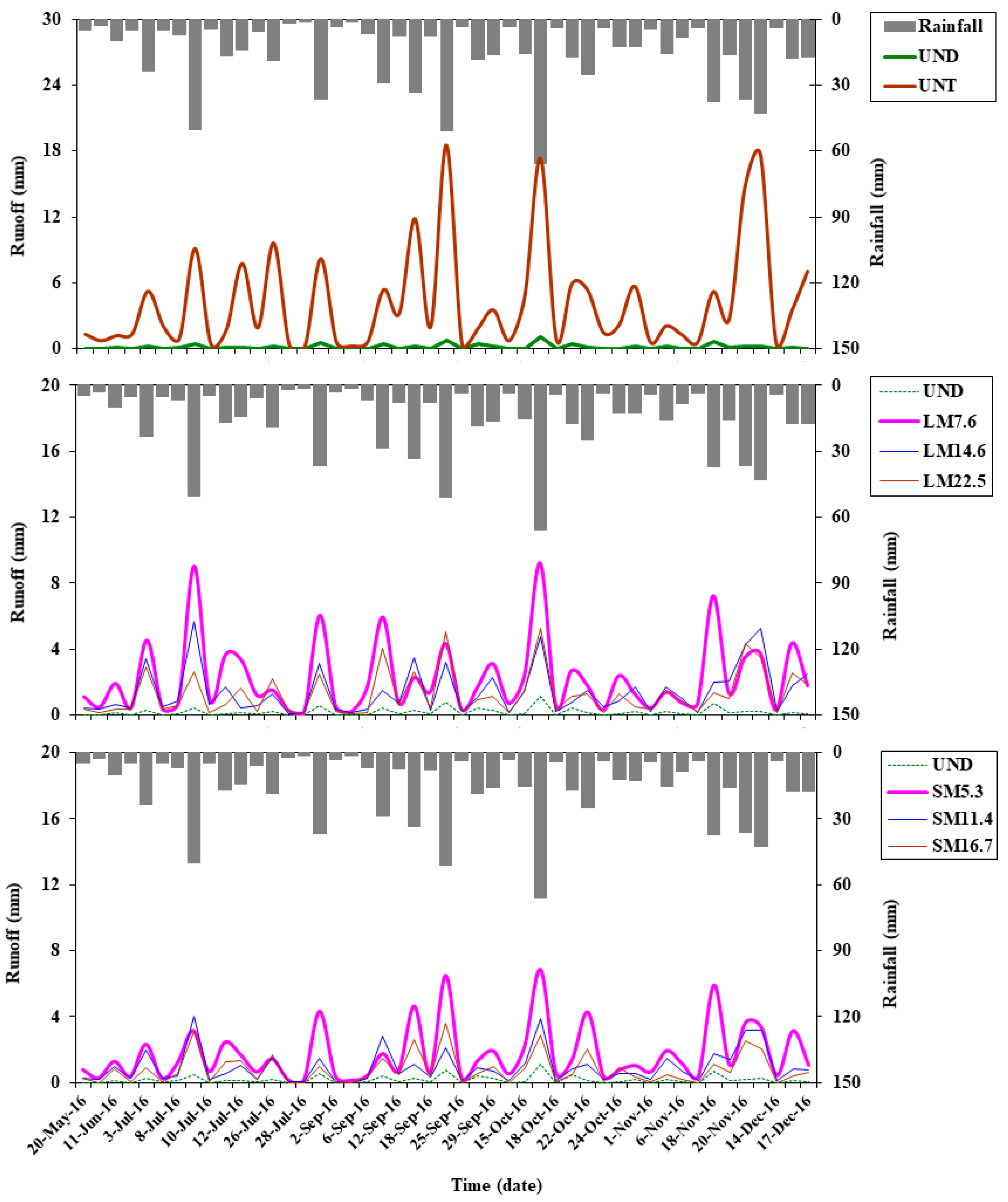

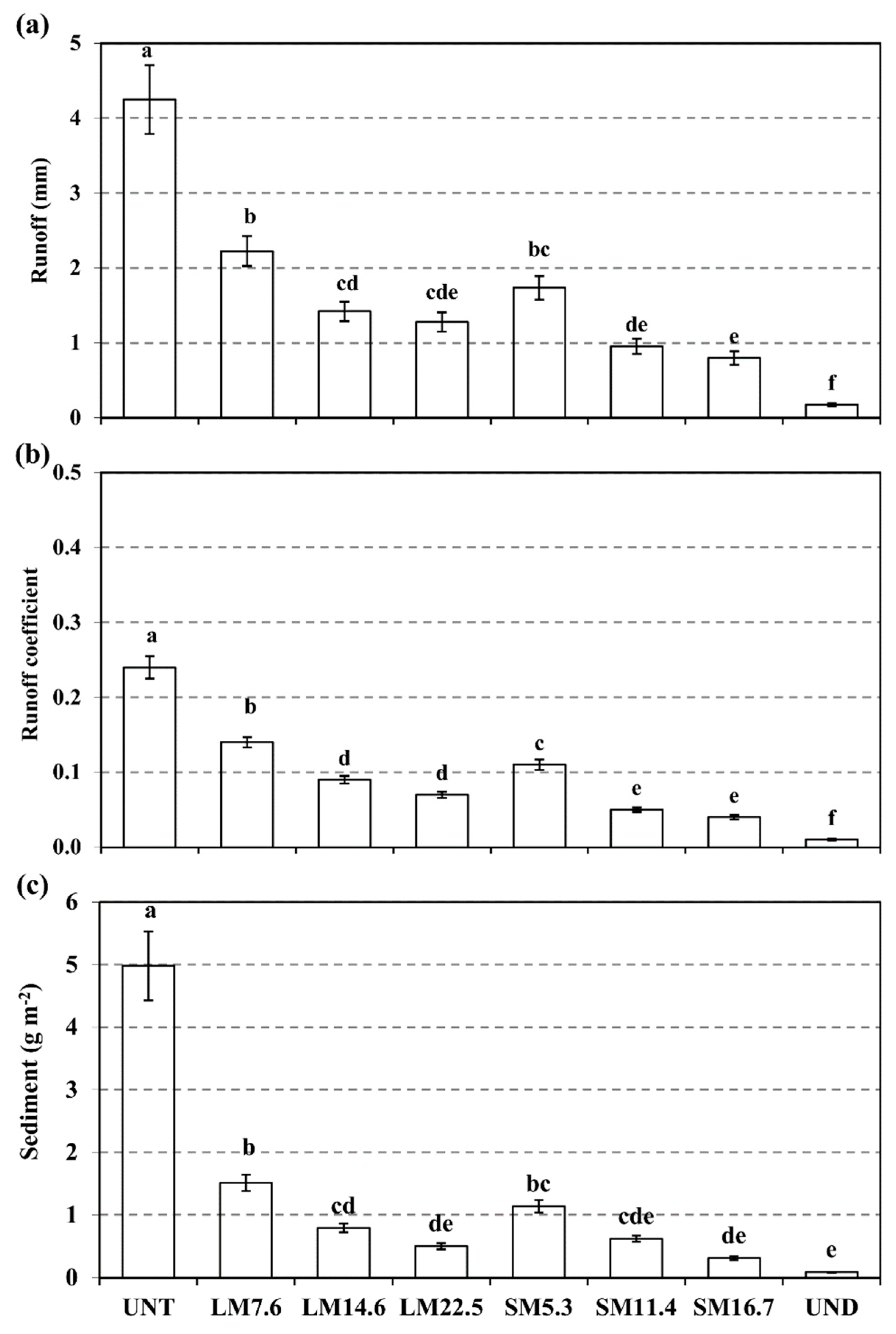
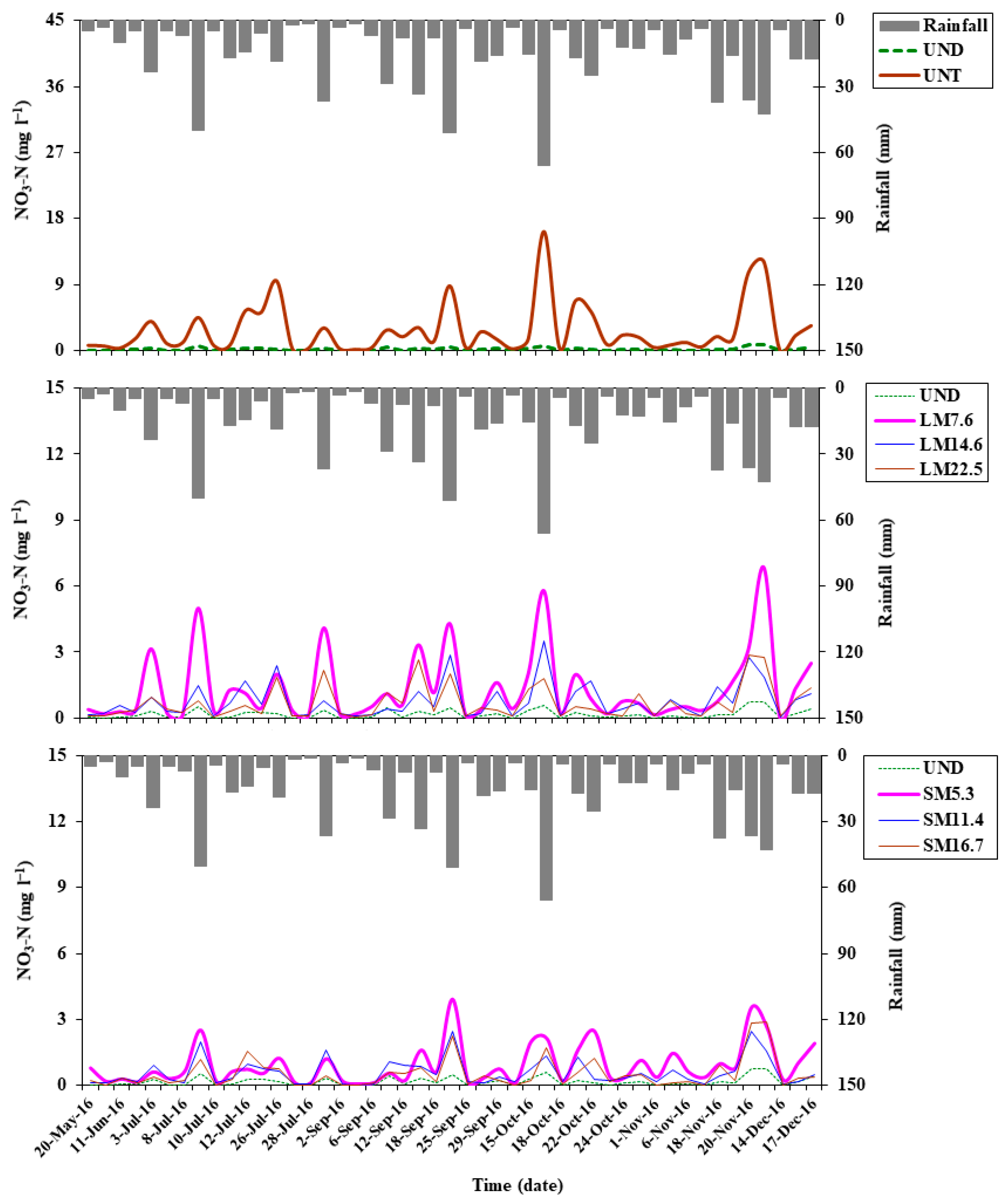

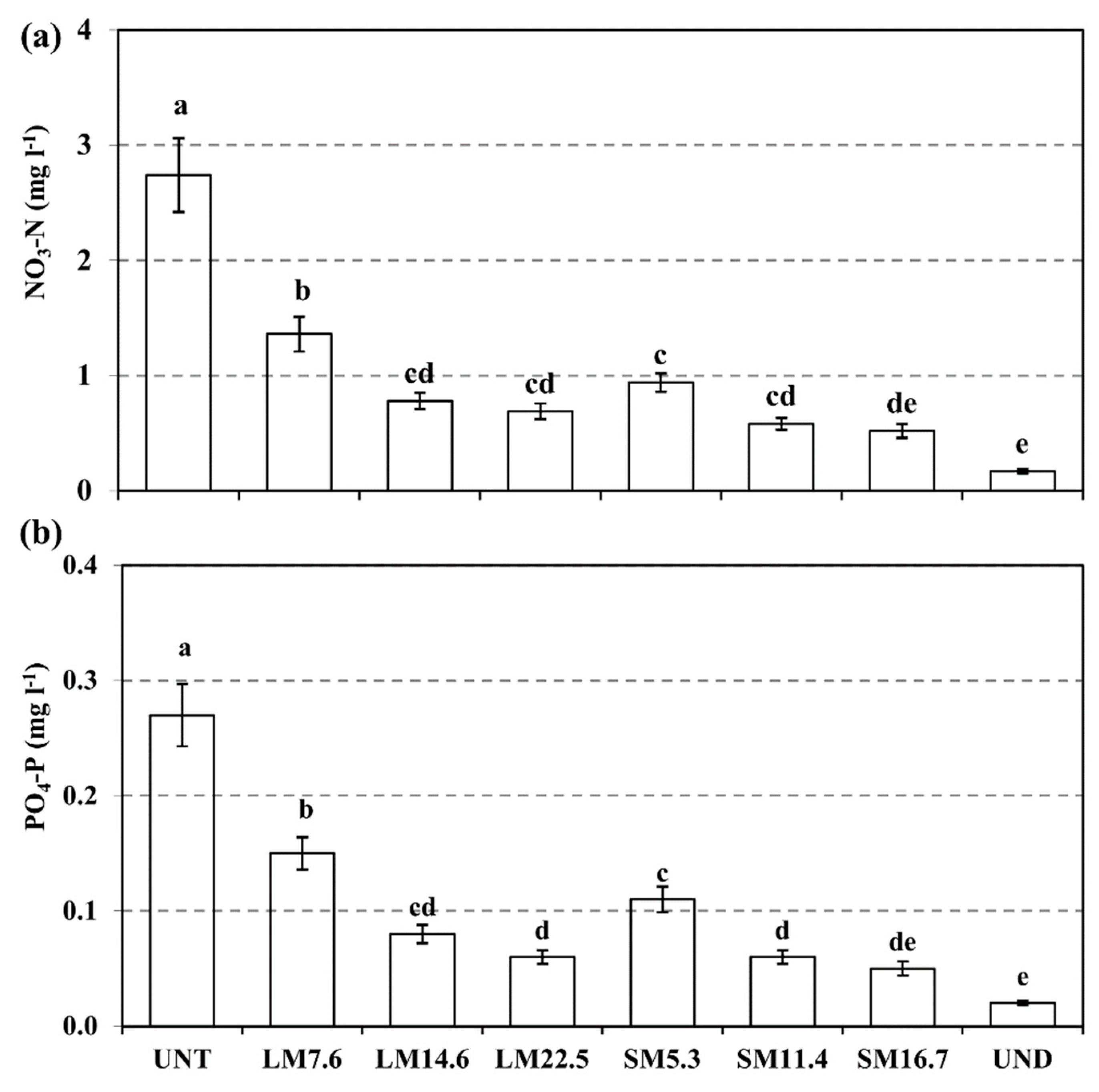
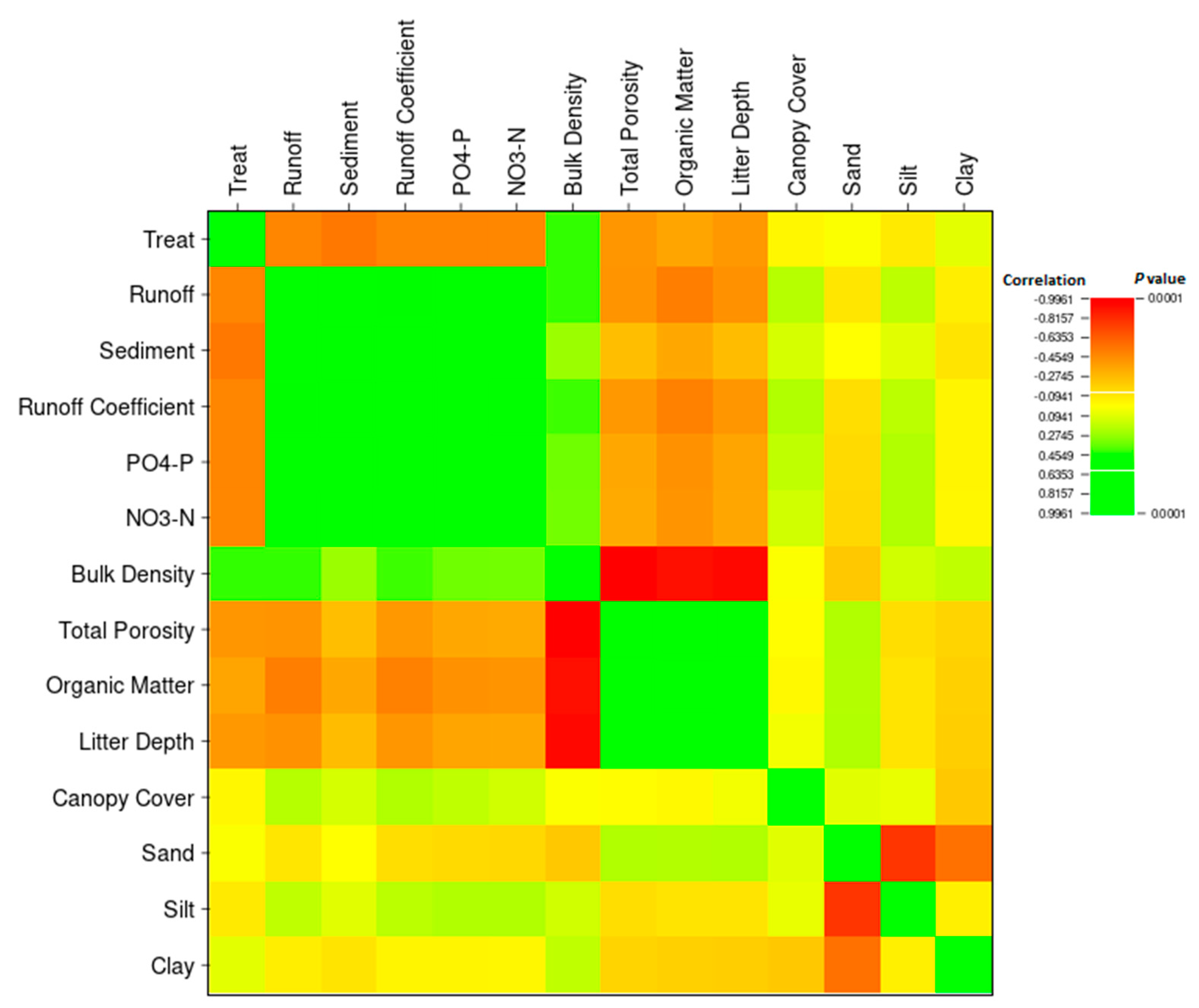
| Treatment | Characteristics | |||||||
|---|---|---|---|---|---|---|---|---|
| Bulk Density (g cm−3) | Total Porosity (%) | Organic Matter (%) | Litter Depth (cm) | Canopy Cover (%) | Sand (%) | Silt (%) | Clay (%) | |
| UNT | 1.30 ± 0.04a | 49.8 ± 1.5b | 3.4 ± 0.4b | 0b | 84.7 ± 2.5a | 41.3 ± 9.3a | 40.3 ± 4.5a | 18.3 ± 4.9a |
| LM7.6 | 1.29 ± 0.03a | 50.5 ± 1.2b | 3.4 ± 0.4b | 0b | 82.7 ± 4.7a | 30.0 ± 2.0a | 45.3 ± 3.2a | 24. 7 ± 1.5a |
| LM14.6 | 1.30 ± 0.04a | 49.8 ± 1.5b | 4.1 ± 0. 6b | 0b | 81.7 ± 3.2a | 35.0 ± 5.0a | 40.3 ± 4.7a | 24. 7 ± 1.5a |
| LM22.5 | 1.30 ± 0.06a | 50.0 ± 2.3b | 4.0 ± 0.3b | 0b | 82.7 ± 3.5a | 29. 7 ± 3.5a | 46.3 ± 2.5a | 24.0 ± 1.0a |
| SM5.3 | 1.31 ± 0.05a | 49.5 ± 1.8b | 3.2 ± 0.8b | 0b | 83.7 ± 2.5a | 34. 3 ± 5.0a | 40. 7 ± 4.0a | 25.0 ± 3.0a |
| SM11.4 | 1.29 ± 0.05a | 50.3 ± 1.7b | 3.7 ± 0.6b | 0b | 81.7 ± 8.1a | 39.0 ± 5.6a | 40. 3 ± 3.2a | 20. 7 ± 4.2a |
| SM16.7 | 1.31 ± 0.05a | 49.5 ± 1.8b | 3.8 ± 0.6b | 0b | 84.3 ± 4.6a | 41. 3 ± 5.1a | 39.0 ± 9.5a | 19. 7 ± 4.9a |
| UND | 0.94 ± 0.05b | 63.8 ± 1. 8a | 9.9 ± 0.6a | 6.2 ± 0.8a | 83.0 ± 6.2a | 39. 7 ± 4.0a | 40.0 ± 7.9a | 20.3 ± 4.7a |
Disclaimer/Publisher’s Note: The statements, opinions and data contained in all publications are solely those of the individual author(s) and contributor(s) and not of MDPI and/or the editor(s). MDPI and/or the editor(s) disclaim responsibility for any injury to people or property resulting from any ideas, methods, instructions or products referred to in the content. |
© 2023 by the authors. Licensee MDPI, Basel, Switzerland. This article is an open access article distributed under the terms and conditions of the Creative Commons Attribution (CC BY) license (https://creativecommons.org/licenses/by/4.0/).
Share and Cite
Tibash, A.; Jourgholami, M.; Moghaddam Nia, A.; Latterini, F.; Venanzi, R.; Picchio, R. The Effects of Organic Mulches on Water Erosion Control for Skid Trails in the Hyrcanian Mixed Forests. Forests 2023, 14, 2198. https://doi.org/10.3390/f14112198
Tibash A, Jourgholami M, Moghaddam Nia A, Latterini F, Venanzi R, Picchio R. The Effects of Organic Mulches on Water Erosion Control for Skid Trails in the Hyrcanian Mixed Forests. Forests. 2023; 14(11):2198. https://doi.org/10.3390/f14112198
Chicago/Turabian StyleTibash, Azar, Meghdad Jourgholami, Alireza Moghaddam Nia, Francesco Latterini, Rachele Venanzi, and Rodolfo Picchio. 2023. "The Effects of Organic Mulches on Water Erosion Control for Skid Trails in the Hyrcanian Mixed Forests" Forests 14, no. 11: 2198. https://doi.org/10.3390/f14112198
APA StyleTibash, A., Jourgholami, M., Moghaddam Nia, A., Latterini, F., Venanzi, R., & Picchio, R. (2023). The Effects of Organic Mulches on Water Erosion Control for Skid Trails in the Hyrcanian Mixed Forests. Forests, 14(11), 2198. https://doi.org/10.3390/f14112198










